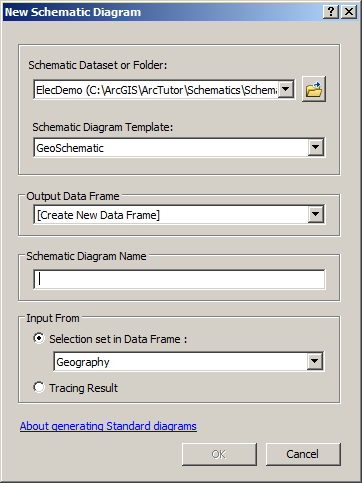Requisito previo:
Before generating diagrams from network features—that is, features organized into a geometric network or a network dataset—you must create a schematic diagram template in your schematic dataset and configure it to work with the Standard builder.
The easiest way to generate Standard builder schematic diagrams from network features is to start ArcMap and create or load an .mxd file that references the geometric network data or the network dataset from which you want the Standard builder to operate. Then, schematic diagrams can be generated from any set of network features that is selected in this map after a manual selection or a selection by attribute, location, or graphics. When your map references a geometric network, you can also use all tools and commands on the Utility Network Analyst toolbar to set up and perform tracing operations on this geometric network and base your schematic diagram generation on the tracing result.
The generated diagrams can then be updated so their content is always in accordance with the geodatabase. When diagram generation is based on a geometric network tracing operation result, the tracing operation's parameters persist in the schematic database, so each time they are updated, ArcGIS Schematics automatically reexecutes the tracing operation and updates the diagram content according to the resulting trace.
The following section details the steps to generate a standard schematic diagram from network features in ArcMap.
- Start ArcMap and load the .mxd file that contains the geometric network or the network dataset from which you want to generate schematic diagrams.
- Do one of the following:
- If the map document references features organized into a geometric network, select a set of features in the map or use the tools on the Utility Network Analyst toolbar to perform a tracing operation on the geometric network.
- If the map document references features organized into a network dataset, select a set of network elements in the map.
- Click the Generate New Schematic Diagram button
 on the Schematic toolbar.
on the Schematic toolbar.
The New Schematic Diagram dialog box opens.

- Click the Schematic Dataset or Folder drop-down arrow and choose the schematic dataset or the schematic folder in the desired schematic dataset where the generated schematic diagram will be stored.
Learn more about the schematic datasets/folders suggested by default in this drop-down list
- Click the Schematic Diagram Template drop-down arrow and choose the schematic diagram template (based on the Standard builder) that will be used to generate the schematic diagram.
All the predefined schematic diagram templates available from the currently selected schematic dataset specified in the Schematic Dataset or Folder drop-down list are itemized in this list.
- Keep the [Create New Data Frame] default value in the Output Data Frame drop-down list so the generated schematic diagram is automatically displayed in a new data frame, or choose the data frame to which you want the generated schematic diagram to be added from that drop-down list.
- Type a name or pick one of the predefined names for the schematic diagram to be generated in the Schematic Diagram Name combo box.
When a custom query is configured for the schematic diagram template, the Schematic Diagram Name control is displayed as a drop-down list with predefined schematic diagram names. These names correspond to the schematic diagram identifiers defined for the related schematic diagram template. In that case, you must select one of the predefined diagram names.
If no custom query is specified for the schematic diagram template, the Schematic Diagram Name control is displayed as a text box where you can type any name for the generated diagram.
- Do one of the following:
- Click the Selection set in Data Frame drop-down arrow and choose the data frame that contains the desired input selection set.
- Choose the Tracing Result option for a diagram generated from the currently highlighted tracing result.
- Click OK.
The schematic diagram is generated and displayed in the specified data frame. It is now referenced in the schematic dataset.